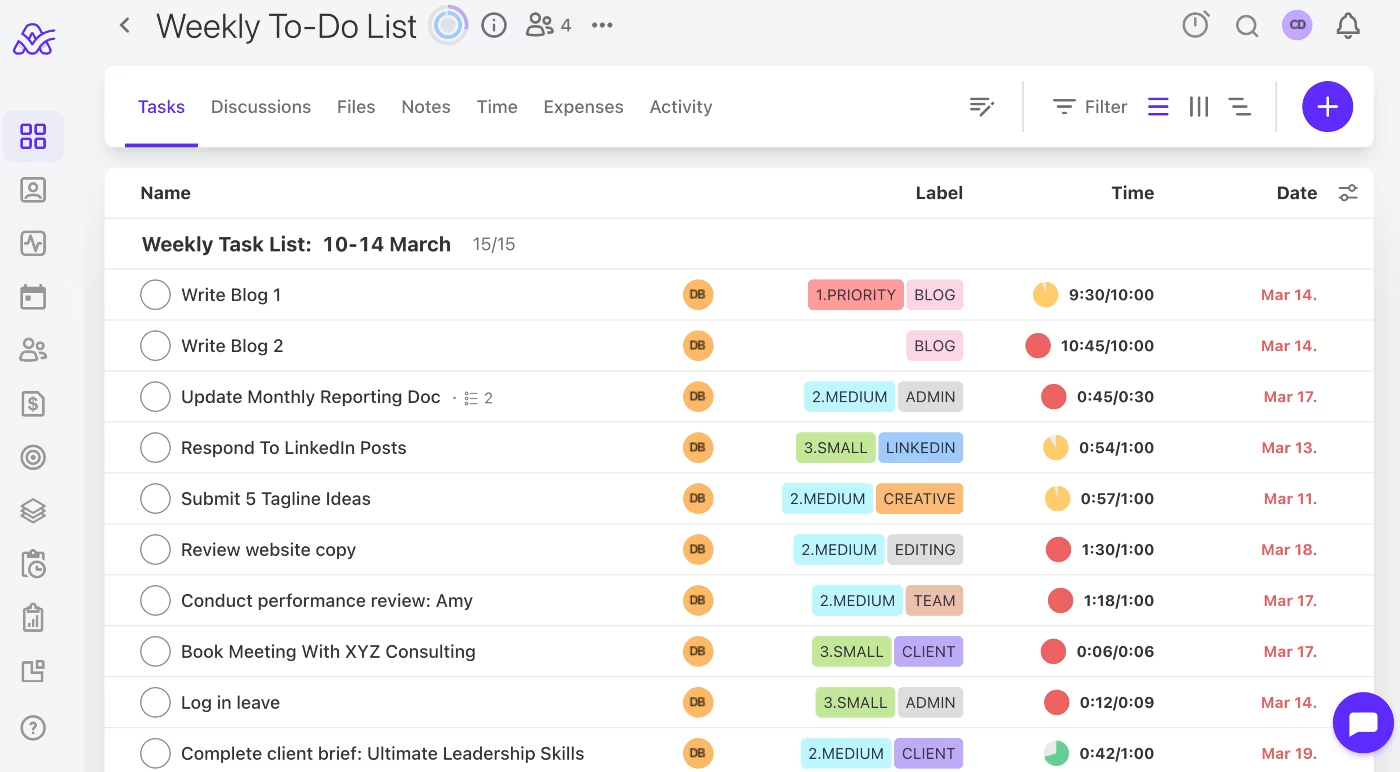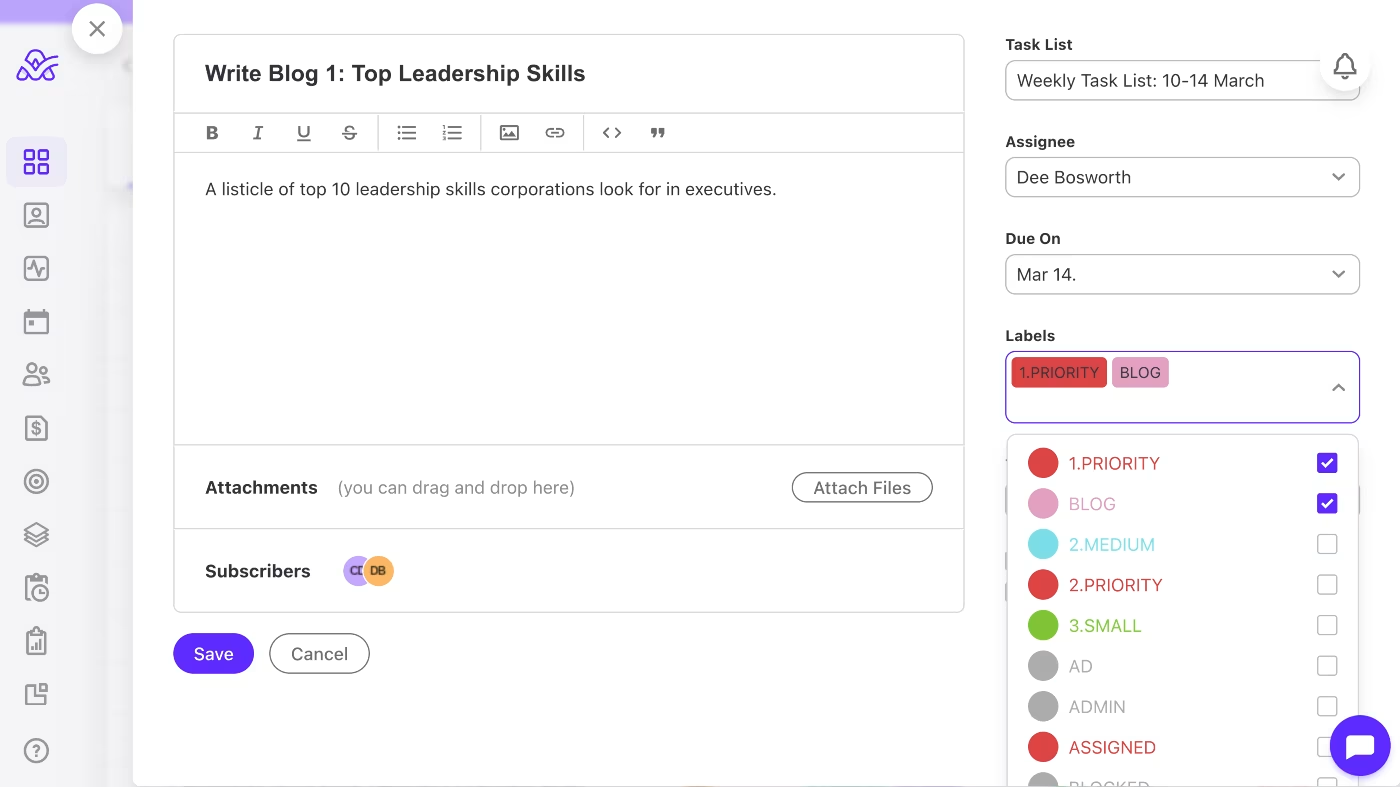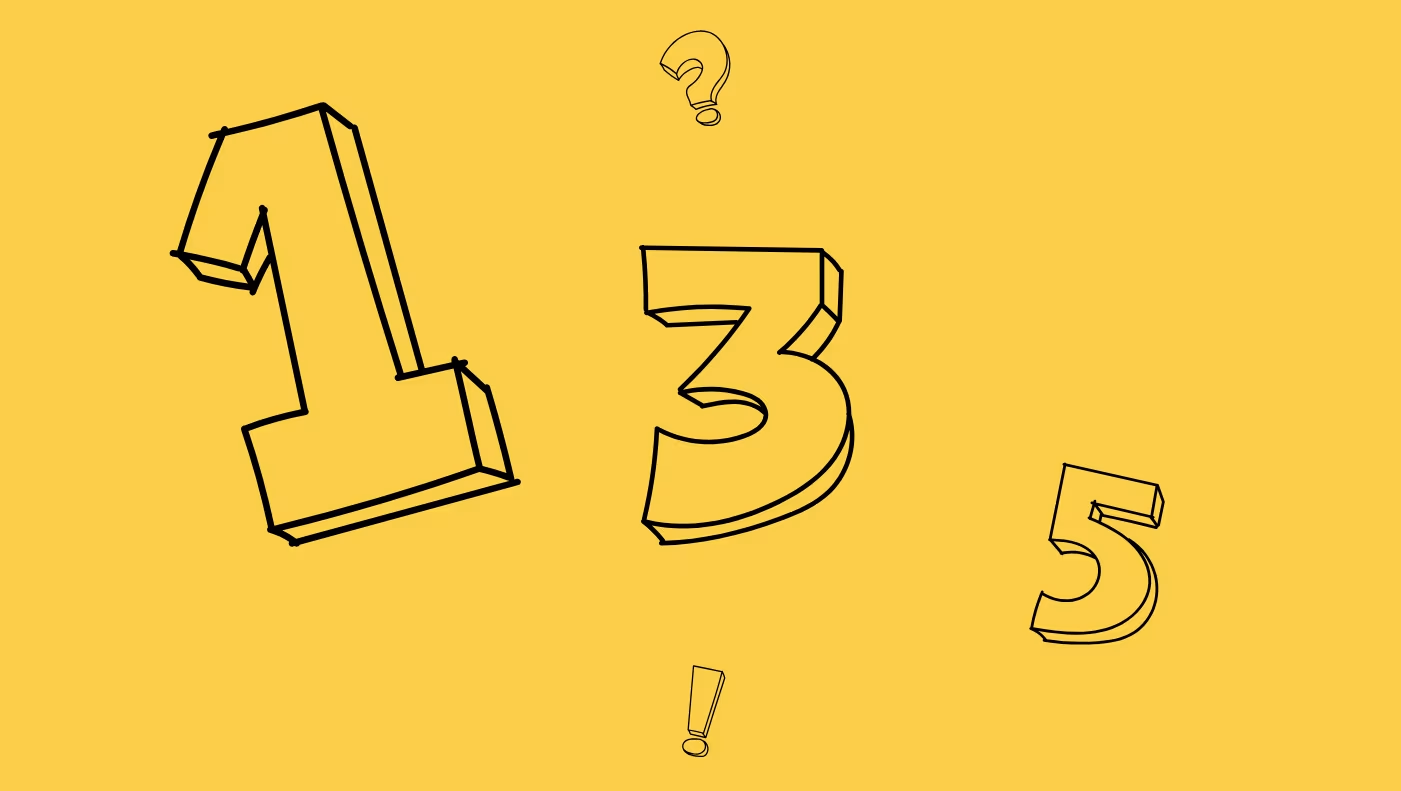Humans are a funny lot. We like setting and achieving goals because it gives us a sense of purpose. We like rules and routines because it keeps us in-line and organized. And we love fail-proof strategies and hacks because they promise to make us more focused, driven, productive and successful beings.
One of those hacks is the 1-3-5 rule. It’s a time management and productivity method that’s super simple to apply, and helps you divide your tasks into manageable chunks, daily.
In this article we tell you what the 1-3-5 rule is, give you examples of scenarios when you should use it, and explain how you can apply it in five easy steps in order to improve your or your agency's productivity.
What Is The 1-3-5 Rule?
The 1-3-5 rule is a hack that helps you better manage your time and tasks so you become more productive, organized, and effective. It involves taking your to-do list and selecting a maximum of nine tasks to complete for the day. Within those nine tasks, you will need to have:
- 1 large, important, big-win task you must complete
- 3 medium, relatively important tasks you need to complete
- 5 small tasks you’d like to complete, but it’s not a deal-breaker if you don’t get to all of them
The idea behind this method is to give you a sense of direction in terms of the order you tackle your tasks in, and to remove the overwhelming feeling that endless to-do lists trigger in us humans.
The 1-3-5 rule helps you achieve greater focus and steers your mind to work with intention rather than mechanical output. It does this by following two two key principles:
1.) Limiting the number of tasks you assign yourself in a day – When you cap your to-do list, you avoid falling victim to optimism bias, and underutilizing your working hours. Being realistic about what you can accomplish in a day and setting realistic and effective time limits to a task lets you work with a clear target and you feel less overwhelmed
2.) Maximizing the impact of your work by categorizing & prioritizing – When you analyze all the items on your list and divide them into categories based on priority, importance, or urgency, you get a better idea of which tasks deserve more time and attention (because they are more impactful), and which can be delayed.
Now that you understand what the 1-3-5 rule is all about, let’s take a look at when you should use and apply it to your professional and personal life.
When Should You Use The 1-3-5 Rule?
There is no limit to how and when you should use the 1-3-5 rule. In essence, whenever you have a long list of items you need to action. It’s also ideal if you feel overwhelmed by your work day or see that your energy and effort is misaligned to priorities.
In both cases, the method can become your secret weapon to achieve more with less stress.
The method works well if you need to:
- Build an effective daily task completion or to-do list strategy
- Organize your work day more effectively
- Manage the stress you experience as a result of multitasking and mixing tasks
- Increase the level of focus and attention you dedicate to tasks
- Action a combination of different tasks across client or portfolios
Insight: According to a HBR article, people have an average of 15 ongoing goals or tasks at any one time. That sounds, and is an unrealistically large number to manage. Time management techniques like the 1-3-5 rule are there to support people to manage time and tasks more efficiently.
5 Steps To Apply the 1-3-5 Rule
To apply the 1-3-5 rule there are four steps you need to take. We go through each one in detail and give you some tips to help you not only action all nine tasks, but also how you can adapt the method on days when things simply pop-up out of the blue.
Step 1: Record All Your Tasks For The Day
The first step is to list all your tasks for the day. Jot them down on paper or into a task management tool like ActiveCollab, like we’ve done below. This will be the master list you’ll use to pull your nine tasks that will make it into your 1-3-5 shortlist.
Note: You might already have a long master task list somewhere in your notes or spreadsheets which you work off continuously. If that’s the case, you don’t need to recreate the wheel, you can just use that as your master, but keep in mind for this purpose, you are only selecting tasks to complete in a single day, and not your entire work month!
Step 2: Highlight Your Large Priority Tasks
Step two is to highlight your large priority tasks. Most of you can spot these a mile away because they tend to be the most challenging, demanding and time-consuming ones in your list (for whatever reason).
To identify them, look for tasks that you would label as:
- Urgent – Must be done now, yesterday or as soon as possible
- Important – Highly important and valued from business strategy or client expectations perspective
- Impactful – Deliver impactful outcomes for your business or clients
- Time-demanding – Demand the most time and focus from you or your team
Examples of large priority tasks at a marketing agency might include creating a content strategy, holding a client strategy workshop, writing website copy or blog content.
If you use a task management tool, you can create a #1 PRIORITY label and assign it to these tasks so you have greater visibility like we’ve done below.

Step 3: Identify Your Medium & Small Tasks
Step three is to divide the rest of the tasks in your list into two categories: medium and small.
Some guidelines on how to work out which is which are:
Medium Tasks
- These are important tasks you need to complete like completing a client brief, reviewing job applications for a new hire or creating SOP documents
- They require a reasonable amount of focus and time to complete, usually between 30-60 minutes
- Medium tasks are important tasks that support the efficiency and profitable running of your business or client portfolios
Small Tasks
- These are usually administrative or busy tasks like updating documents, setting up meeting invites or responding to emails
- They tend to be tasks that don’t take a lot of time, 15-20 minutes at most
- In most cases they are not business-critical tasks
To make the next step easier, we’ve also assigned 2.MEDIUM and 3.SMALL labels to tasks in these last two categories of the 1-3-5 rule.
Step 4: Select Your 1-3-5 Rule Tasks
Step four is to select which tasks will make it to your 1-3-5 rule list for the day. While this may seem super simple when you have a short master list, it can be extremely difficult if you have multiple tasks competing for priority in each category.
The one most important factor that will determine your choice across all three categories is deadlines and bottlenecks. Tasks with impending deadlines will take priority over items due at a later date. Also, tasks that are creating bottlenecks for your team or clients will also need to be addressed before others because they have a roll-on impact.
There are a few other things to consider when selecting your tasks for each category.
Tips For ‘1’ Tasks
If your ‘1’ task is a large piece of work that can’t be finished in one day, divide it into 2-3-hour chunks and over 3 days.
Ask yourself:
Am I setting a realistic and achievable expectation?
Also, if you know you have a super busy day ahead of you, choose smaller, easier ‘1’ tasks to tackle and leave the more complex ones for a day that’s less intense.
Ask yourself:
Have I made the right selection for today’s work schedule intensity and capacity?
Tips For ‘3’ Tasks
When selecting your ‘3’ tasks, try to choose related tasks to minimize context switching which churns cognitive focus.
Ask yourself:
Which three tasks are connected in terms of topic, client or work type?
To avoid wasting time choosing which of the three tasks you’ll do first, set the order you’ll complete them in by numbering them 1-3.
Ask yourself:
Should I prioritize my medium tasks by key clients or by task size?
Tips For ‘5’ Tasks
If small tasks carry a great value being completed because they are bottlenecks, they might be worth moving up into the medium category.
Ask yourself:
Even though this is a small task, does its value or flow-on impact make it a better fit for the ‘3’ category?
Most of the ‘5’ tasks will be things you can complete in any order because they don’t take a long time and can be grouped into miscellaneous administrative musts.
Ask yourself:
Which tasks are low-demand, quick wins that give me an immediate sense of accomplishment?
Step 5: Schedule Time To Complete Tasks
The last step is to schedule time into your diary when you’ll complete each task or group of tasks. We have three pieces of advice when it comes to scheduling.
Do The Big ‘1’ Task First
It might be enticing to get those small tasks out of the way first but that defeats the purpose of this method. Starting with your ‘1’ large task lets you take advantage of your cognitive focus when it’s at its highest: in the morning.
Leave The Last ‘5’ For The End
On the opposite end of the scale, it’s best to schedule your last five, small tasks for the end. It’s when your focus is at its lowest, which makes it the most appropriate time for ad-hoc administrative must-dos.
Use Historical Time Logs
Not knowing exactly how long a task will take can leave you allocating too much, or too little time. Tools like ActiveCollab, let you set task time estimates and track how long it takes you to finish using the timer. That way you have a bunch of data you can reference to make more accurate time scheduling decisions in future.
Pros & Cons Of Using The 1-3-5 Rule
Every method has its perks, but it’s also bound to have some downsides. Before you test the 1-3-5 rule, it’s a good idea to keep an eye out for some of the good things the technique will help you achieve. However, you should also be aware of difficulties you might face which might not make it the best approach for every person or work scenario.
The Good Stuff | The Not So Great Stuff |
Promotes workload balance – It combines small and large tasks so your work day is less mundane. | Unrealistic task number –Nine tasks per could be a little unrealistic in the real-world |
Clarity on daily goals –You know exactly how many and which tasks your setting out to accomplish. | Not for all professions –Creatives or writers may not find it applicable to their tasks |
Builds resilience – Actioning the largest, hardest task first builds a resilience to difficult tasks. | Landing a time estimate –Working out the distribution of time across nine tasks could be overwhelming |
Let ActiveCollab & The 1-3-5 Rule Make You More Productive
The 1-3-5 rule is the productivity hack you turn to when your to-do list spirals out of control. If you combine the method with a task management tool you can save yourself from chaos.
As a task management platform ActiveCollab helps teams and professionals centralize, streamline, prioritize, and track tasks to completion. Whether you are managing a team of dozens, have hundreds of tasks across projects, or are looking to find a better way to manage your to-do list, the tool can simplify and bring clarity to your day.

Used by project and account managers across service-based businesses, it lets you organize your action items and set customized labels by priority or work type.With a handy in-app time tracker and reporting dashboards, you can see how long it takes you to complete individual tasks, and use the time entries to understand how your working hours are distributed.
If you need a tool to give your day structure and help you land a more effective way to achieve daily goals, you need to turn to ActiveCollab. Sign up for our 14-day free trial or book a demo with one of our people to see how you and your entire team can work more productively.

